This article was co-authored by Mark Co, DPM. Dr. Mark Co is a Podiatrist who runs his own private practice in San Francisco, California. Dr. Co specializes in treatments for bunions, ingrown toenails, toenail fungus, warts, plantar fasciitis and other causes of foot pain. He also offers custom orthotics for the treatment and prevention of foot and ankle issues. Dr. Co completed a Master of Business Administration (MBA) at New York University and an MA in Electrical Engineering and Computer Science at Johns Hopkins University. Dr. Co also completed his DPM at the California School of Podiatric Medicine and a residency and internship at the Kaiser Permanente Medical Center, Santa Clara, California. Dr. Co was awarded San Francisco's "Top 3 Podiatrists" in 2018, 2019, and 2020. Dr. Co is also a member of the CPMA (American Podiatric Medical Association).
There are 8 references cited in this article, which can be found at the bottom of the page.
This article has been viewed 89,003 times.
Plantar fasciitis is a common cause of pain in the heel and the bottom of the foot. The plantar fascia is a thick band of tissue that connects the heel bone to the toes. It can be torn, stretched, or injured and become inflamed. Once inflamed, the condition is called plantar fasciitis.[1] If you have injured your plantar fascia, you can learn how to relieve the pain.
Steps
Using Home Remedies to Treat Plantar Fasciitis Pain
-
1Rest your foot. One of the best ways to relieve the pain of plantar fasciitis is to rest it. This means staying off of it as much as you can. When you are home or at work, try to stay seated and only walk on it if you have to. You might consider using crutches for a few days to take all pressure off the foot.[2]
- If you usually do exercises that use your foot, consider doing something different, like swimming or weight lifting.
-
2Use a foot support. An arch support can help distribute the pressure of your foot in an even way, which can take the extra stress off your plantar fascia. You can also use a heel cup. [3] You can get an arch support without a prescription at many drug stores, medical supply stores, and pharmacies.
- Examples of arch supports that come with a soft cushion are Spenco and Cross Trainers. For some people, a custom-made support may be needed. These can be acquired through your doctor.
- You can also see a podiatrist to get a custom orthotic that will support your arch and foot ligaments.[4]
- When you're choosing shoes, look for a sturdy shoe with a modest heel, maybe 1–1.5 in (2.5–3.8 cm). Make sure the shoe doesn't twist and turn—if the shoe bends, it should only be at the widest part of the shoe, near the toe box.[5]
Advertisement -
3Use an ice pack. Ice is helpful with plantar fasciitis pain because it works to reduce inflammation. You can use an ice pack on the bottom of your foot for 20 minutes three to four times a day. You can also try using an ice bath, which is where you soak your foot in an ice and water mixture for about ten to fifteen minutes.[6]
- Make sure to place a cloth or towel between the ice pack and your skin.
- Heat generally doesn't help plantar fasciitis pain, but if the ice doesn't help, you can try a heating pad after a couple days to see if it will relieve pain.
Stretching to Relieve Foot Pain
-
1Do a wall stretch. This stretch helps to lengthen and stretch your arch and Achilles tendon. Start by leaning forward against a wall, keeping one knee straight and the same leg's heel flat on the ground. Bend your other knee. You will feel the Achilles tendon and foot arch on the straight leg stretch as you lean forward.[7]
- Hold this pose for 10 seconds. Then, relax and straighten up. Repeat 20 times with both legs.
- Plantar fasciitis pain is actually caused by tight muscles in your calf, which is where your Achilles tendon originates.[8] Stretching your Achilles tendon can help relieve your pain, especially if you do it before and after you exercise.[9]
-
2Perform a squat stretch. This stretch also focuses on your arch and tendons. Lean forward onto a counter top. Spread your feet shoulder width apart, keeping one foot in front of the other. Bend your knees and slowly squat down. Try to keep your heels on the ground for as long as you can.[10]
- You will feel your Achilles tendon and foot arch stretch as you squat down.
- Hold the squat for 10 to 15 seconds. Then, relax and straighten up.
- Repeat 20 to 25 times.
-
3Stretch the sole of your foot with your hands. This stretch helps to lengthen the plantar fascia and is similar to what you will do if you wrap your foot. Cross whichever leg is affected over your other leg. Using the hand on the same side as the hurt foot, grab the sore foot and gently pull your toes back towards your shin.[11]
- This creates some tension or stretch in the arch of the foot and at the plantar fascia.
- Hold this stretch for 10 to 20 seconds and repeat 10 times. You can also massage the arch with your thumb, which can help break down any scar tissue that's causing you pain.[12]
-
4Do all foot stretches gently. The American Orthopaedic Foot and Ankle Society recommends doing stretches that target your Achilles tendon and plantar fascia to help treat plantar fasciitis and reduce the risk of a recurring injury. For these exercises, make certain you move slowly, gently, and smoothly. Don't make any quick movements because this may re-injure the plantar fascia.[13]
- Repeat these exercises at least three times a day. Do these stretches especially after you have been sitting for a long time and when you get out of bed in the morning, when plantar fasciitis pain tends to be worst. Look for other times that you can incorporate stretching into your schedule, as well, like when you're having a meal or brushing your teeth.[14]
Wrapping Your Foot to Relieve Plantar Fasciitis Pain
-
1Sit in a comfortable position. The first thing you need to do when wrapping your foot is to get into a comfortable position. You can rest the affected foot on the opposite knee if that is comfortable. Make sure you have good access to your foot so you can stretch it and wrap it properly.[15]
- Wrapping your foot can reduce the pain in your foot by keeping it stretched. It also helps minimize any stress and inflammation. There are night splints available at most medical supply stores, but you can often replicate these for much less money.
-
2Wrap the bandage around your ankle. Gently pull your toes up toward your head. You should feel a light stretch, but no serious pain. Place one end of the elastic bandage on the top of your foot. Keeping your foot flexed, wrap the elastic band around your foot. Then bring it around your ankle.
- The main goal of wrapping your foot is to keep the foot flexed with the toes pointing or pulled toward your head until you feel a stretch in the bottom of your foot. Remember this should only be a gentle stretch.
-
3Continue wrapping the bandage around your foot. After one wrap around your ankle, loop the elastic bandage back to your foot. Fold the bandage and slip the folded bandage between your big toe and first toe. Then pull the bandage back to the ankle. Continue wrapping around your ankle, tucking the end of the elastic bandage under the wrapped bandage when you are finished.
- Make sure you keep your foot flexed with toes pointed toward your head during the entire process.
- You don't have to wrap tightly. The point of the elastic bandage is not to compress but to keep your foot flexed and the plantar fascia gently stretched.
- Be careful when standing up or getting out of bed. Do this slowly.
Treating Plantar Fasciitis Pain Medically
-
1Use OTC pain medications. A common way to relieve pain from plantar fasciitis is to take over-the-counter pain medication. You can use OTC anti-inflammatory medications to help decrease the inflammation and the pain in your foot. These medications include Ibuprofen, such as Advil and Motrin, and Naproxen, like Aleve.[16]
- Use the medication only as directed on the package. You can take these medications for up to two weeks.
-
2Try corticosteroids. If you have plantar fasciitis pain that doesn't respond to any of the home treatments, you may want to see your doctor. Your doctor may suggest corticosteroids if you have pain that just won't go away. Usually, these injections work better if done early; however, doctors usually only administer them in more severe cases.[17]
- Your doctor will probably suggest other at-home methods before giving you these injections.
- Multiple shots are not recommended. This can weaken your plantar fascia or diminish the pad that covers your heel bone.
- Before you get an injection, you will have to get a radiograph of the food.
-
3Undergo surgery. In the most severe cases where the pain doesn't decrease and the plantar fascia doesn't heal with other treatments, a physician may suggest surgery. In the surgery, a surgeon will release your plantar fascia from the heel bone. This is the last resort option for pain.[18]
- If you undergo this surgery, you may end up with a weakened foot arch.
Expert Q&A
Did you know you can get expert answers for this article?
Unlock expert answers by supporting wikiHow
-
QuestionHow can I treat plantar fasciitis at home?
 Mark Co, DPMDr. Mark Co is a Podiatrist who runs his own private practice in San Francisco, California. Dr. Co specializes in treatments for bunions, ingrown toenails, toenail fungus, warts, plantar fasciitis and other causes of foot pain. He also offers custom orthotics for the treatment and prevention of foot and ankle issues. Dr. Co completed a Master of Business Administration (MBA) at New York University and an MA in Electrical Engineering and Computer Science at Johns Hopkins University. Dr. Co also completed his DPM at the California School of Podiatric Medicine and a residency and internship at the Kaiser Permanente Medical Center, Santa Clara, California. Dr. Co was awarded San Francisco's "Top 3 Podiatrists" in 2018, 2019, and 2020. Dr. Co is also a member of the CPMA (American Podiatric Medical Association).
Mark Co, DPMDr. Mark Co is a Podiatrist who runs his own private practice in San Francisco, California. Dr. Co specializes in treatments for bunions, ingrown toenails, toenail fungus, warts, plantar fasciitis and other causes of foot pain. He also offers custom orthotics for the treatment and prevention of foot and ankle issues. Dr. Co completed a Master of Business Administration (MBA) at New York University and an MA in Electrical Engineering and Computer Science at Johns Hopkins University. Dr. Co also completed his DPM at the California School of Podiatric Medicine and a residency and internship at the Kaiser Permanente Medical Center, Santa Clara, California. Dr. Co was awarded San Francisco's "Top 3 Podiatrists" in 2018, 2019, and 2020. Dr. Co is also a member of the CPMA (American Podiatric Medical Association).
Podiatrist Stretch your calf and Achilles tendon to relieve the pain. Try laying on the bed with your knees straight and your legs extended. Put a towel, belt, or band underneath your forefoot and gently pull your foot upward to stretch your Achilles tendon. You can also use a topical balm for muscle pain each night before you go to sleep, like Tiger Balm or Icy Hot.
Stretch your calf and Achilles tendon to relieve the pain. Try laying on the bed with your knees straight and your legs extended. Put a towel, belt, or band underneath your forefoot and gently pull your foot upward to stretch your Achilles tendon. You can also use a topical balm for muscle pain each night before you go to sleep, like Tiger Balm or Icy Hot. -
QuestionHow can I avoid getting plantar fasciitis?
 Mark Co, DPMDr. Mark Co is a Podiatrist who runs his own private practice in San Francisco, California. Dr. Co specializes in treatments for bunions, ingrown toenails, toenail fungus, warts, plantar fasciitis and other causes of foot pain. He also offers custom orthotics for the treatment and prevention of foot and ankle issues. Dr. Co completed a Master of Business Administration (MBA) at New York University and an MA in Electrical Engineering and Computer Science at Johns Hopkins University. Dr. Co also completed his DPM at the California School of Podiatric Medicine and a residency and internship at the Kaiser Permanente Medical Center, Santa Clara, California. Dr. Co was awarded San Francisco's "Top 3 Podiatrists" in 2018, 2019, and 2020. Dr. Co is also a member of the CPMA (American Podiatric Medical Association).
Mark Co, DPMDr. Mark Co is a Podiatrist who runs his own private practice in San Francisco, California. Dr. Co specializes in treatments for bunions, ingrown toenails, toenail fungus, warts, plantar fasciitis and other causes of foot pain. He also offers custom orthotics for the treatment and prevention of foot and ankle issues. Dr. Co completed a Master of Business Administration (MBA) at New York University and an MA in Electrical Engineering and Computer Science at Johns Hopkins University. Dr. Co also completed his DPM at the California School of Podiatric Medicine and a residency and internship at the Kaiser Permanente Medical Center, Santa Clara, California. Dr. Co was awarded San Francisco's "Top 3 Podiatrists" in 2018, 2019, and 2020. Dr. Co is also a member of the CPMA (American Podiatric Medical Association).
Podiatrist
-
QuestionWhy does stretching my legs help my foot feel better?
 Miguel Cunha, DPMDr. Miguel Cunha is the founder of Gotham Footcare and is a podiatrist based in Manhattan, New York. Dr. Cunha is a foot and ankle surgeon with experience treating a wide array of foot and ankle conditions from minor problems to complex reconstructive foot and ankle surgery. Dr. Cunha received his DPM from the Temple University School of Podiatric Medicine and completed his residency as the Chief Resident at the Washington Hospital Center and Georgetown University where he specialized in lower extremity trauma, diabetic limb salvage, and reconstructive surgery of the foot and ankle. Dr. Cunha is a member of the American Podiatric Medical Association, the New York Podiatric Medical Association, the American College of Foot and Ankle Surgeons, and is board certified in Podiatric Medicine.
Miguel Cunha, DPMDr. Miguel Cunha is the founder of Gotham Footcare and is a podiatrist based in Manhattan, New York. Dr. Cunha is a foot and ankle surgeon with experience treating a wide array of foot and ankle conditions from minor problems to complex reconstructive foot and ankle surgery. Dr. Cunha received his DPM from the Temple University School of Podiatric Medicine and completed his residency as the Chief Resident at the Washington Hospital Center and Georgetown University where he specialized in lower extremity trauma, diabetic limb salvage, and reconstructive surgery of the foot and ankle. Dr. Cunha is a member of the American Podiatric Medical Association, the New York Podiatric Medical Association, the American College of Foot and Ankle Surgeons, and is board certified in Podiatric Medicine.
Board Certified Podiatrist
References
- ↑ http://www.mayoclinic.org/diseases-conditions/plantar-fasciitis/basics/definition/CON-20025664
- ↑ http://www.aafp.org/afp/2001/0201/p467.html
- ↑ http://www.mayoclinic.org/diseases-conditions/plantar-fasciitis/basics/treatment/con-20025664
- ↑ Mark Co, DPM. Podiatrist. Expert Interview. 21 April 2020.
- ↑ Mark Co, DPM. Podiatrist. Expert Interview. 21 April 2020.
- ↑ http://www.aafp.org/afp/2001/0201/p467.html
- ↑ https://www.aofas.org/footcaremd/conditions/ailments-of-the-heel/Pages/Plantar-Fasciitis.aspx
- ↑ Miguel Cunha, DPM. Board Certified Podiatrist. Expert Interview. 1 February 2020.
- ↑ Mark Co, DPM. Podiatrist. Expert Interview. 21 April 2020.
- ↑ https://www.aofas.org/footcaremd/conditions/ailments-of-the-heel/Pages/Plantar-Fasciitis.aspx
- ↑ https://www.aofas.org/footcaremd/conditions/ailments-of-the-heel/Pages/Plantar-Fasciitis.aspx
- ↑ Miguel Cunha, DPM. Board Certified Podiatrist. Expert Interview. 1 February 2020.
- ↑ https://www.aofas.org/footcaremd/conditions/ailments-of-the-heel/Pages/Plantar-Fasciitis.aspx
- ↑ Miguel Cunha, DPM. Board Certified Podiatrist. Expert Interview. 1 May 2020.
- ↑ https://heelthatpain.com/plantar-fasciitis/taping/plantar-fasciitis-taping/
- ↑ http://www.mayoclinic.org/diseases-conditions/plantar-fasciitis/basics/treatment/con-20025664
- ↑ http://www.aafp.org/afp/2001/0201/p467.html
- ↑ http://www.mayoclinic.org/diseases-conditions/plantar-fasciitis/basics/treatment/con-20025664
About This Article
Plantar fasciitis is a common cause of pain in the heel and bottom of the foot. To relieve the pain, apply an ice pack or a bag of frozen vegetables wrapped in a towel to your foot for 20 minutes a few times a day. This will help reduce any inflammation. Try doing some gentle squats or stretch your leg while leaning against a wall. This will help to stretch your Achilles' tendon and relieve your pain. It’s also important to rest your foot as much as possible while it heals. If you need to move around, use crutches for a few days. You can also get arch support inserts for your shoes to take the pressure off your plantar fascia. If it still hurts, try wrapping your foot and ankle in a bandage, which keeps your foot stretched and reduces pressure and inflammation. For more tips, including how to treat long-term plantar fasciitis pain with medical aids, read on.
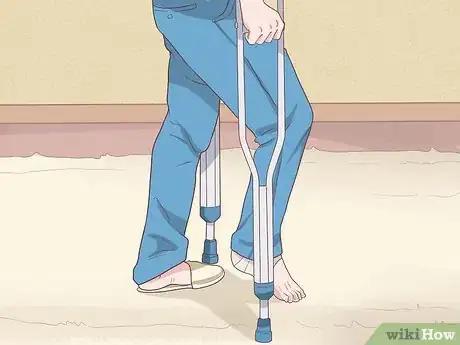
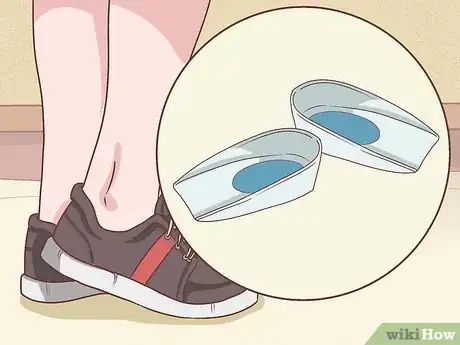

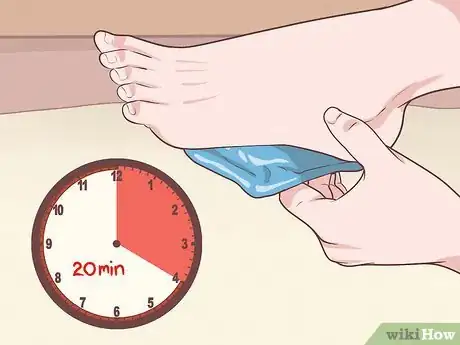
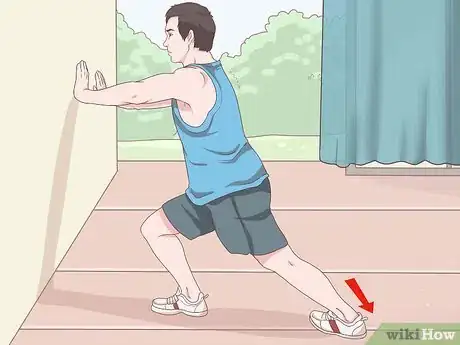

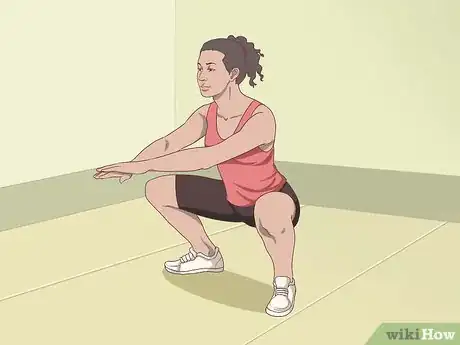
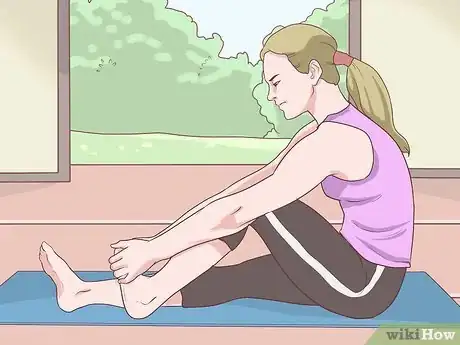
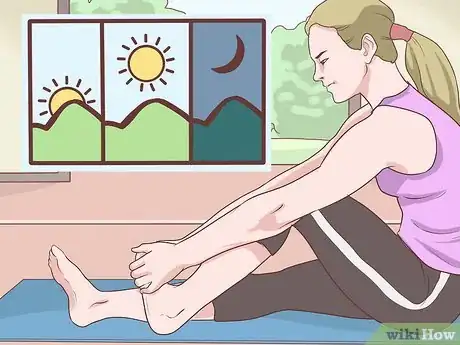
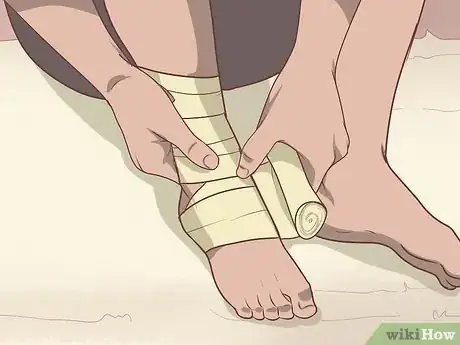
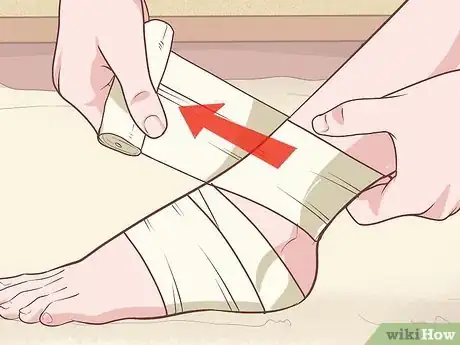
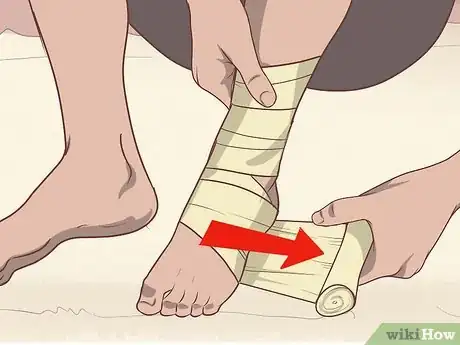

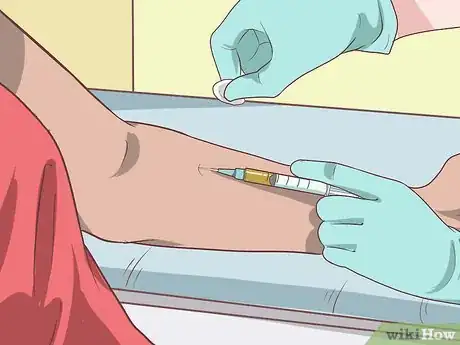
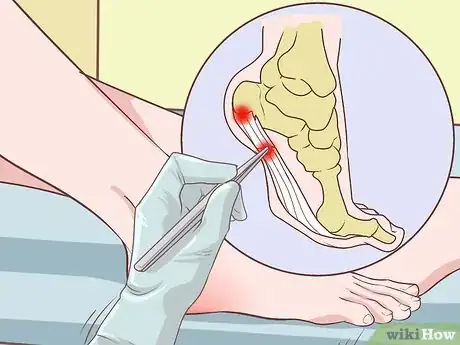
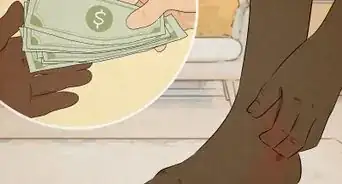
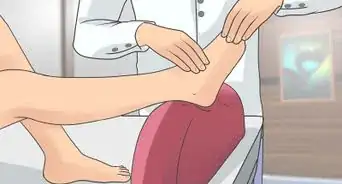

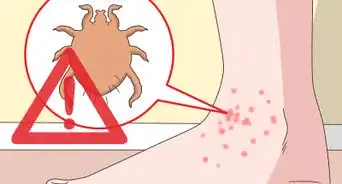




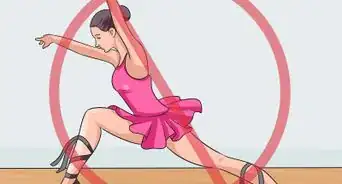

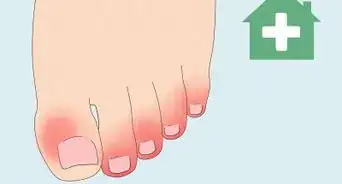

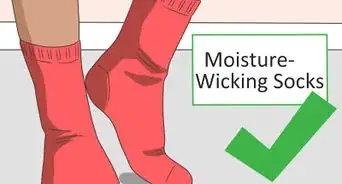
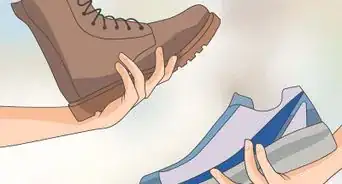







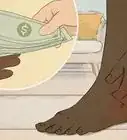
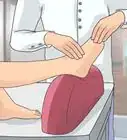

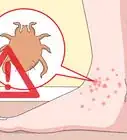



































Medical Disclaimer
The content of this article is not intended to be a substitute for professional medical advice, examination, diagnosis, or treatment. You should always contact your doctor or other qualified healthcare professional before starting, changing, or stopping any kind of health treatment.
Read More...